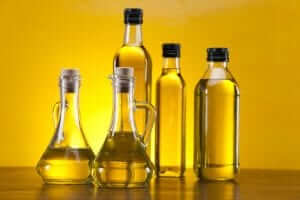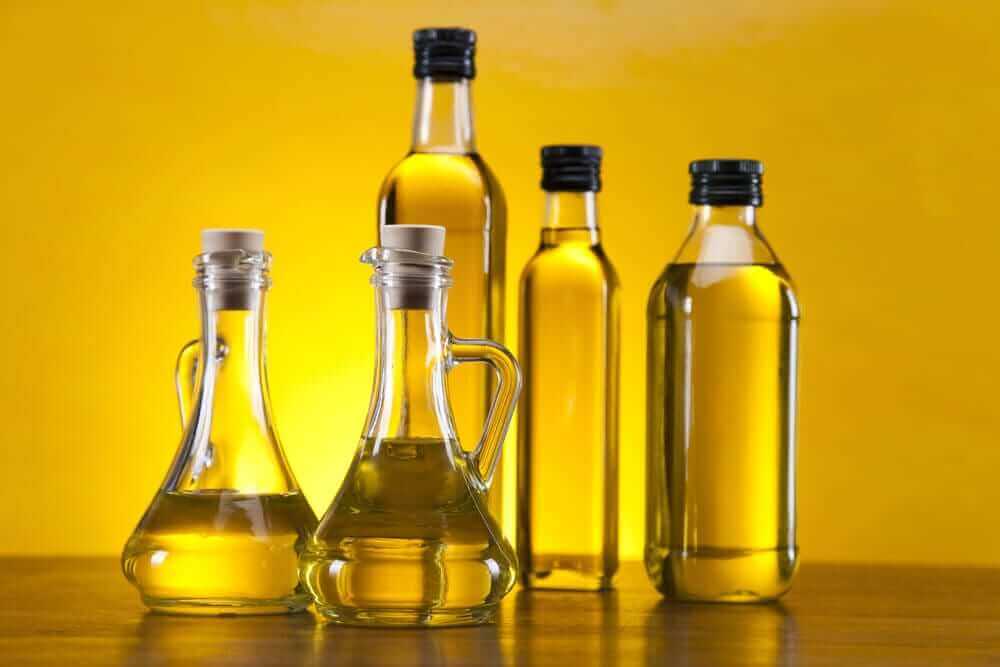When we think of fats in the horse’s diet, the first few things that come to mind are to improve the shine in a hair coat or to put weight on a horse in need. Although these are both true, there is much more to fats that what meets the eye and thus, a better understanding is needed. Fats are valuable sources of energy and calories, but there are potentials downfalls as they impact health on many levels, and not every horse is in need.

There are several different types of fats, which we will get to shortly, but overall fat is present in all grains and forages but levels and types of fat can vary. In most forages and grains, fats are generally present as di-triacylglycerols, glycolipids and phospholipids. Oils, which are commonly supplemented to feeds are generally present as triacylglycerols, which are also commonly referred to as triglycerides. The difference is digestibility, which can vary. Forages demonstrate a digestibility of 5-57%, grains 55-76% and oils range from 64-96%. The reason for this variability, as hypothesized, is that in the oils, the triglycerides are freely available, while in the forages and grains, we have to include the variability of plant cell wall material, which may impede or slow digestion and thus digestibility. It has also been noted that comparing the two groups really is not fair, due to the fact that the forages/grains contain much lower levels of fat as compared to the oils, thus overall levels post digestion may be skewed. This is not saying one is better than the other, when it comes to health, just mainly noting the differences.
Without getting too complicated, the di-triacylglycerol fats are essentially two or three fatty acids bound to a glycerol backbone. Fatty acids that are present in the fat and are not bound to the glycerol unit are referred to as ‘free fatty acids’ and often used, when present, as an indicator of rancidity or oxidation of the fat, which can be a bad thing. To go one step further, again not trying to complicate matters, but the fatty acids can also be further subclassed as saturated, monounsatured or polyunsaturated, which is dependent on their chemical composition and presence of double bonds, from a biochemistry point of view. All in all, we have all heard reference to saturated fats in our diet and see them noted on food labels. Saturated fats are often more stable and are solid at room temperature, while mono or polyunsaturated fats are often liquid at room temperature. The difference between an actual stick of butter that stays solid on the counter or a bottle of olive oil which stays in suspension or liquid form.
The equine digestive tract is designed to handle low fat, high fiber diets. Despite this, research has indicated that higher fat diets are fairly well tolerated, but there are some areas of concern or gray zones within that research. Some studies have indicated that higher fat diets do not impair other nutrient absorption, while in other studies, this was found not to be true and lowered nutrient absorption was noted. One thing that is certain is that fat is needed in the diet to enhance absorption of fat soluble vitamins including Vitamin A, D and E. Therefore, the potential does exist that a low fat diet could theorectically result in those vitamin deficiencies.
When looking a naturally occuring fat levels, most grains and forages are naturally low, demonstrating less than 4% DM. Oils are naturally higher and considered to be 100% fat. Higher fat equine feeds and supplements generally provide greater than 5% fat and the addition of other ingredients such as rice bran, flax seed and sunflower seeds to the normal diet can increase levels up to 20% on average. The one issue to be raised, when mentioning rice bran or flax seed is that both of them naturally contain higher levels of phosphorus than calcium, beyond the NRC recommended ratio. Thus, if these fat sources are used in high quantities, in relation to the rest of the diet, nutrient imbalance may occur.
In regards to exact or specific levels of fat required for each horse, this cannot be readily determined, but is more so based on that horse as an individual, current diet and demands placed on the body. This will vary tremendously from one horse to the next.
Essential Fatty Acids:
Just like with proteins, essential fatty acids are those that must be provided in the diet as the body cannot produce them. The two main essential fatty acids (EFAs) of concern or focus are Linoleic acid (LA) and Alpha-Linolenic acid (ALA). Linoleic acid is also referred to as Omega-6 fatty acids, while Alpha-Linolenic acid is referred to as Omega-3 fatty acids. Again, omega fatty acids are likely a common term to most readers due to hype in nutrition and research on health, which we will address shortly. We are often told that omega-6 fatty acids are ‘bad’, while omega-3 fatty acids are ‘good’. Although there is some truth to this, we must understand that it is about balance.
Linoleic acid can be metabolized to yield DGLA (dihomo-γ-linolenic acid) and AA (arachidonic acid), while alpha-linolenic acid can be metabolized to yield EPA (eicosapentaenoic acid) and DHA (docosahexaenoic acid).
Fatty acids impact cell function, cell membrane integrity, immune function, gene expression and even inflammation. Both are important to health for various reasons, but again, it is about balance. Omega-6 and omega-3 fatty acids compete with one another for uptake into cell membranes, which then impacts a host of different cellular processes as mentione above. Omega-6 fatty acids, when metabolized, generally produce higher levels of pro-inflammatory proteins in the body, while omega-3 fatty acids generally result in lower levels of inflammatory proteins being produced. This is why omega-3 fatty acids are perceived as being more ‘anti-inflammatory’ in nature. Thus, higher intakes of omega-6 fatty acids are deemed harmful due to contributions to inflammation. Again, it is about balance as both are important and over consumption of one over the other, can result in negative outcomes for health.
Essential fatty acid deficiencies have not been noted in the horse, even when on low fat diets, possibly due to mobilization and use of stored fats. The National Research Council (NRC) has recommended an intake of Linoleic acid (omega-6) to be 0.5% DM, which is roughly equivalent to 50 grams based on a diet of 2% BW intake. There are no recommendations or values for intake of alpha-linolenic acid (omega-3) in the horse, as it is assumed that with a high quality forage diet, the levels will be likely sufficient. The generally accepted ratios are 5:1 to 10:1 (omega-6:omega-3), which is really based on data from other species. In humans, the current average ratio, due high intake of processed and fatty foods is around 20:1 (omega 6:3). Thus, you can see where the problem comes and the concern raised regarding cardiovascular and other health issues.
Forages are generally higher in omega-3 fatty acids, while grains are higher in omega-6 fatty acids. Taking this into application, diets higher in forages will yield higher levels of omega-3 fatty acids, while those higher in grains will yield higher omega-6 fatty acid levels. In situations where grains make up a large percent of the diet, which is common in the racing industry, we then have higher levels of omega-6 fatty acids in the diet, which if the balance is too far off, could contribute to inflammatory problems, ranging from ulcer to lameness concerns. This is then potentially doubled if we add oils to that regimen.
Fatty Acid Supplementation:
Many horse owners supplement with fats or oils of various forms, often doing this without justification, while others do have specific reasons such as improvement in hair coat or weight conditioning. The question comes as to whether every horse needs fat supplementation and if so, how do we go about doing this? Again, it is an individual horse situation and really dependent on many factors. As you can see in the chart below, we can get a better indication of various levels of fats and essential fatty acids types in different food sources.
| Food Source | Fat | SFA | MUFA | PUFA | LA | ALA |
| Grass hay, cool season | 22.1 | 3.7 | 1.2 | 12.0 | 3.8 | 8.2 |
| Grass hay, warm season | 20.0 | 5.3 | 0.6 | 8.2 | 3.6 | 4.6 |
| Grass pasture, cool season | 25.0 | 4.0 | 1.5 | 13.8 | 4.5 | 9.3 |
| Grass pasture, warm season | 24.4 | 6.3 | 0.7 | 15.0 | 3.9 | 11.1 |
| Legume hay | 25.5 | 5.2 | 0.8 | 11.8 | 3.9 | 7.9 |
| Barley grain | 23.0 | 4.8 | 3.0 | 11.1 | 10.0 | 1.1 |
| Corn grain | 47.4 | 6.7 | 12.5 | 21.6 | 21.0 | 0.7 |
| Flax seed | 421.6 | 36.6 | 75.3 | 287.3 | 59.0 | 228.1 |
| Linseed meal | 19.0 | 3.4 | 4.2 | 9.5 | 2.1 | 7.3 |
| Oat grain | 54.0 | 9.2 | 19.6 | 24.4 | 23.2 | 1.0 |
| Rice bran | 208.5 | 41.7 | 75.5 | 74.6 | 71.4 | 3.2 |
| Sunflower seed | 514.6 | 44.6 | 185.3 | 231.4 | 230.5 | 0.6 |
| Canola oil | 1000 | 73.7 | 632.8 | 281.4 | 186.4 | 91.4 |
| Coconut oil | 1000 | 865.0 | 58.0 | 18.0 | 18.0 | 0 |
| Corn oil | 1000 | 129.5 | 275.8 | 546.8 | 532.3 | 11.6 |
| Fish oil (Herring) | 1000 | 212.9 | 565.6 | 156.0 | 11.5 | 7.6 |
| Flaxseed oil | 1000 | 94.0 | 202.0 | 660.0 | 127.0 | 533.0 |
| Olive oil | 1000 | 138.1 | 729.6 | 105.2 | 97.6 | 7.6 |
| Rice bran oil | 1000 | 197.0 | 393.0 | 350.0 | 334.0 | 16.0 |
| Sunflower oil | 1000 | 90.1 | 573.3 | 289.6 | 287.1 | 0.4 |
(Levels expressed as g/kg DM. SFA(saturated fatty acids), MUFA (monounsaturated fatty acids), PUFA (polyunsaturated fatty acids), LA (Linoleic acid), ALA (alpha linolenic acid). Chart modified and adapted from Geor et al 2013)
Through looking at this chart, we can see that the forages provide a higher level of omega-3 fatty acids, than omega-6. The reverse is true for the grains, which have higher levels of omega-6 fatty acids in relation to the omega-3. Some grains have moderately high levels of fats overall, including Flax, Sunflower and Rice bran. In regards to oils, most contain relatively high levels of omega-6 fatty acids, with corn being of the highest. Flaxseed oil has the highest levels of omega-3 fatty acids in relation to omega-3.
In regards to reduction of inflammation, generally, it is recommmended to increase omega-3 fatty acids in relation to omega-6. The two most common sources of omega-3 fatty acids in the horse industry are Flax seed and fish oils. Fish oils are generally highest in omega-3 fatty acids, but are not a normal part of the equine diet. They are also less tolerable and accepted due to odor, taste and in many cases, have high levels of heavy metals, including mercury.
One word of caution regarding all fats and high fat diets is rancidity, which is due to oxidation of the fatty acids. High levels of rancidity are potentially harmful to the body, as we are potentially increasing intake of free radicals which can cause damage. Whole seeds are generally less susceptible to oxidation as compared to crushed or milled seeds, with oils being the most susceptible. If you are using any of these mediums, you need to use caution and be able to determine by taste, odor and color, whether oxidation has occurred or no. As an example is olive oil, which when purchased is often a clear color, but over time with storage in our kitchen cabinet, the color begins to turn darker. This is due to oxidation, which can be slowed by storing in a air tight container and even refrigerating.
Overall, omega-3 supplementation has shown benefits in many species, including humans, regarding impact on inflammation, but the science in the horse is lacking. In some studies, there are evident benefits with reduction of inflammatory proteins, while in other equine studies, the data contradicts the other. Overall, it is a mixed bag of results as compared to other species. Just because it has shown benefit in one species, does not mean those results transfer to others.
In regards to human models of insulin resistance, it has been noted that transitioning from a diet high in saturated fatty acids to one with more mono or polyunsaturated acids improved inflammatory markers and insulin sensivity. What is not know is whether it was the mono or polyunsaturated fatty acids that were responsible or just the fact that saturated fatty acid intake was reduced? In many of these studies, they are also increasing fiber intake, so again, we don’t specifically know who the main player was. Overall, a movement in the diet towards a higher omega-3:6 ratio, in addition to higher fiber is beneficial in many respects.
In the end, the question is whether to supplement or not supplement a particular horse. The answer to this is dependent on that specific horse, their diet, current demands and health issues. If a horse with inflammatory problems, which may include allergies or even joint disease, is on a high grain diet or low quality roughage, which may be supplying a higher level of omega-6 fatty acids than we would like, then supplying a new source of omega-3 fatty acids may be beneficial. Those horses that are already overweight or metabolic should have a caution flag raised, in my opinion, as supplementation will likely result in added calories and adding to the weight problem. An overweight or obese body condition has been shown to correlate with higher levels of inflammation within the body.
Horse that are undergoing prolonged, moderate exercise generally are recommended to be on higher fat diets, 8-10%, while those that are doing short bursts of high intensity exercises such as racing, might actually benefit from a lower fat diet, 5-6%. This is due to the perception that the later of the two groups may benefit more from carbohydrates being used as the energy source, rather than fat.
From my clinical perspective, I have witnessed a tremendous amount of oil supplementation or fat in general. In many cases, owners would use high levels of rice bran powder in the horses feed, while others would rely very heavily on corn oil. In most of these cases, the end goal was weight gain for the patient, as they were often underweight. The majority of these patients often did not do well and the goal of weight gain was not achieved. In these cases, usually the problem was a medical one or a dental one, or even parasites which were not addressed. In other cases, there was actually an inflammatory problem, which quickly became worse due to added levels of omega-6 fatty acids and contribution to inflammation. In a high majority of those cases, the problem stemmed back to poor quality nutrition. Pastures were not maintained and of low quality, forages were likewise of low nutrient value and they opted to compensate with high amounts of grain and added oils. Considering what we have discussed, it is not difficult to see why these patients did not respond over the long term or even worsened.
If you do add oil to a horse’s regimen, we have to do it slowly, adding in small amounts every 4-5 days and monitoring that horse for signs of intolerance which may be reluctance to eat or even digestive upset. The exact amount to be added to the feed is dependent on the end goal. If we are just looking to improve shine to a coat, then 1/4-1/2 cup added to the diet may be sufficient, while in other cases, we may need up to 2 cups per day. In either case, we move slowly.
Bottom line…each horse is an individual. If quality forage is provided, with grain in moderation, then in most cases, the level of fat provided should be sufficient. If supplementation is required, you should carefully consider the source chosen and how this impacts overall health and pre-existing conditions.
To learn more about carbohydrates and the horse diet.
To learn more about protein and the horse diet.
I hope this information helps.
Tom Schell, D.V.M.
Nouvelle Research, Inc.
References:
Geor, RJ et al. Equine Applied and Clinical Nutrition. Saunders. 2013, 136-155
Lewis, L. Equine Clinical Nutrition. Williams and Wilkins. 1995. 22
Hoffman, RM et al. Dietary carbohydrates and fat influence radiographic bone mineral content of growing horses. J Anim Sci. 1999. 77;3330-3338
Kronfeld, DS et al. Fat digestibility in Equss caballus follow increasing first order kinetics. J Anim Sci. 2004, 82;1773-1780


